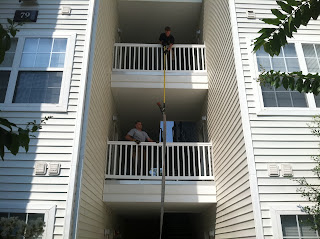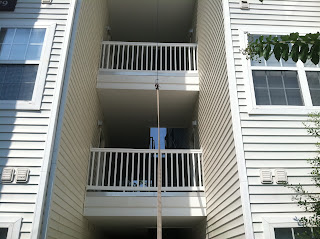In an earlier post I talked about the heavy reliance, in my
geographical area, on the 200’ 1.75” hoseline for interior fire attack in residential
occupancies. With that said, I am
a fan of having, and utilizing, many options for hoseline stretches. The 200’ 1.75” hoseline is an option,
but it’s not the only option nor is it the right option in all instances. However, the intent of this post is to
look at how to maximize your company’s effectiveness when stretching a 200’
1.75” hoseline.
The fireground is full of obstacles and features that have
the potential to influence hoseline stretches. Some of these obstacles or features may include: parked
cars, setbacks, street signs, trees, stairs, hills, or downed power lines. Regardless of the obstacles or features
encountered, a hoseline still needs to get to the seat of the fire. Through observation, preplanning, and
training, a company may identify these feature or obstacles and determine methods
to overcome them.
Garden apartments are a common building in my response areas
at work and at my volunteer firehouse.
Anyone familiar with garden apartments know that these occupancies
present numerous obstacles and features that influence hoseline stretches. Within the last year, my volunteer
department responded to a reported apartment fire and arrived as the second due
Engine Company. Companies went on
the scene with “smoke showing” from the third floor. The second due Engine Company is responsible for securing
the water supply for the first due Engine Company and stretching a second line
to back-up the first due Engine Company.
The first due Engine Company led off by deploying a 400’ leader line,
200’ of 1.75” connected to 200’ of 2.5” via a gated wye. Often in Northern Virginia, the second
line is deployed off of the first due Engine Company. This isn’t always the case, nor do I think it should
be. Regardless, that’s another
topic for another day. Anyways,
our Engine Company crew attempted to deploy a 200’ 1.75” hoseline off of the
first due Engine Company until they were told by the first due Engine driver that
the line would not reach. Since
the crew was very young, they listened to the Engine driver and failed to
deploy a second line.
The end result was fireworks in the stairwell and no fire
department services were required.
However, our company had failed to complete their mission: deploying a
second line. There were many options
they could have exercised including extending or “making up” a line, however
the 200’ 1.75” hoseline would have been more than sufficient. Unfortunately in a reactive manner, I
later made it a point to ensure our folks know how to maximize the effectiveness
of the 200’ 1.75” hoseline. This
post will look at four hoseline stretch options that any Engine Company should
be able to perform.
The first stretch option is the stair stretch. Simply follow the course laid out by
the corridor and stairs, and deploy the hoseline in that course. This stretch obviously uses a lot of
hose and potentially involves making several turns, depending on the type of
stairs that are encountered. Using
the stair stretch, we have found that it is difficult to get sufficient hose
beyond the third floor when deploying a 200’ 1.75” hoseline. Of course, the amount of setback
encountered will heavily influence how far you get. The picture below shows that the nozzle barely made the
fourth floor landing utilizing the stairwell stretch and would not be
sufficient to conduct fire suppression operations on that floor.
The second stretch option is the well stretch. Utilizing a feature of the building,
the well of the stairs, the hoseline is advanced vertically. The hoseline stretch option is
dependant on the presence, and size, of a well. The well must be large enough to accommodate a charged hose
and couplings. A quick way to
determine if the well is of sufficient size is to place a clenched fist in the
well. If your fist will fit,
generally a 1.75” hoseline will fit.
The success of this stretch, as with most stretches, is dependant on
teamwork amongst the Engine Company.
The nozzle firefighter can not prematurely drop hose and the back-up
firefighter must be diligent about keeping the hose in the well during the
stretch. The well stretch gave us
approximately 75’ of hose on the fourth floor landing. This was more than enough hose to
conduct fire suppression operations on the fourth floor.
The third stretch option is the hook stretch. The hook stretch is a stretch on the
exterior of the building and involves vertically stretching a hoseline up the
exterior of the building. The hook
stretch utilizes two firefighters and an 8’ hook. The nozzle firefighter advances hose to the bottom of an
exterior stairwell, while the back-up firefighter goes to the second floor with
an 8’ hook. The 8’ hook is lowered
off of the second floor landing by the back-up firefighter with the head of the
hook pointing down. The nozzle
firefighter hooks the bale of the nozzle on the head of the hook and reports to
the third floor landing.
Simultaneously the back-up firefighter hoists the hook vertically and
passes it to the nozzle firefighter on the third floor landing. This process is repeated until the
nozzle reaches the desired floor.
The hook stretch gave us approximately 100’ of hose on the fourth floor
landing. The hook stretch can also
be completed from windows in buildings with an interior stairs.
The fourth stretch option is the rope stretch. The rope stretch, like the hook
stretch, is a vertical exterior stretch.
The rope stretch utilizes two firefighters and a rope. The nozzle firefighter advances the
nozzle to the bottom of an exterior stairwell, while the back-up firefighter proceeds
to the desired floor with a rope.
The back-up firefighter drops the rope down to the nozzle firefighter,
while maintaining one end of the rope.
The nozzle firefighter secures the rope to the bale of the nozzle and
the back-up firefighter hoists the hoseline up the exterior of the building
using the rope. Like the hook
stretch, this stretch option gave us approximately 100’ of hose on the fourth
floor landing and can be done from windows in buildings with interior stairs.
While these are not the only options that can be exercised
to maximize the effectiveness of 200’ 1.75” hoselines, they are four options
that any Engine Company should be able to perform. Regularly deploying hoselines, on incidents and during
drills, will improve Engine Company operations and will allow a company to
maximize their efficiency and effectiveness.







No comments:
Post a Comment